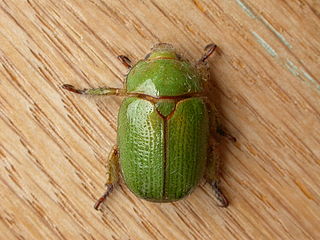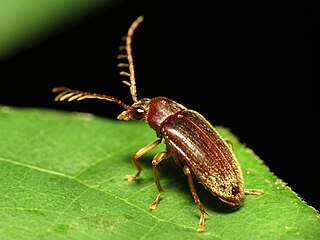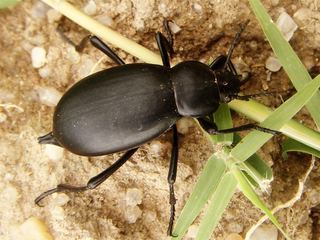
Beetles are insects that form the order Coleoptera, in the superorder Holometabola. Their front pair of wings are hardened into wing-cases, elytra, distinguishing them from most other insects. The Coleoptera, with about 400,000 described species, is the largest of all orders, constituting almost 40% of described insects and 25% of all known animal species; new species are discovered frequently, with estimates suggesting that there are between 0.9 and 2.1 million total species. However, the number of beetle species is challenged by the number of species in dipterans (flies) and hymenopterans (wasps).

Darkling beetle is the common name for members of the beetle family Tenebrionidae, comprising over 20,000 species in a cosmopolitan distribution.

Zophobas atratus is a species of darkling beetle, whose larvae are known by the common name superworm, kingworm, barley worm, morio worm or simply Zophobas. Superworms are common in the reptile pet industry as food, along with giant mealworms.

Zophobas is a genus of beetles in the family Tenebrionidae, the darkling beetles. They occur in the Americas, from the Neotropics into southernmost United States. In Cuba beetles of this genus are known as blind click-beetles.

Zopherus is a genus of beetles comprising 19 species. They live in the Americas and are adapted to wood-boring.

Alphitobius diaperinus is a species of beetle in the family Tenebrionidae, the darkling beetles. It is known commonly as the lesser mealworm and the litter beetle. It has a cosmopolitan distribution, occurring nearly worldwide. It is known widely as a pest insect of stored food grain products such as flour, and of poultry-rearing facilities and it is a vector of many kinds of animal pathogens. In larval form, it is an approved novel food in the European Union, and also used as animal feed.

Phaleria is a genus of darkling beetles belonging to the family Tenebrionidae.

Anoplognathus prasinus, commonly known as the green Christmas beetle, is a beetle of the family Scarabaeidae native to eastern Australia.

Neomida is a genus of darkling beetles in the family Tenebrionidae. There are about 18 described species in Neomida.

Diaperini is a tribe of darkling beetles in the family Tenebrionidae. There are about 13 genera and at least 40 described species in Diaperini.

Platydema is a genus of darkling beetles in the family Tenebrionidae. There are at least 60 described species in Platydema.

Stenochiinae is a subfamily of darkling beetles in the family Tenebrionidae. There are more than 390 genera in Stenochiinae.

Uloma is a genus of darkling beetles in the family Tenebrionidae. There are at least 50 described species in Uloma.

Ptilodactyla is a genus of toe-winged beetles in the family Ptilodactylidae. There are more than 30 described species in Ptilodactyla.

Piestus is a genus of flat rove beetles in the family Staphylinidae. There are more than 30 described species in Piestus.

Lagriinae is a subfamily of long-jointed beetles in the family Tenebrionidae. There are more than 270 genera in Lagriinae, grouped into 11 tribes.

Blaps is a genus of darkling beetles in the family Tenebrionidae. There are more than 30 described species in Blaps, the genus being most commonly found in Eurasia and Australia, with occasional sightings elsewhere in the world.

Diaperis is a genus of darkling beetle with species known from Asia, Europe, and the Americas. Some species were formerly placed in the genus Allophasia. A species described in this genus is now Serrania viridula.
Alphitobiini is a tribe of darkling beetles in the family Tenebrionidae. There are about eight genera in Alphitobiini.

Blaptini is a tribe of darkling beetles in the family Tenebrionidae. There are more than 30 genera recognised in the tribe Blaptini.



















